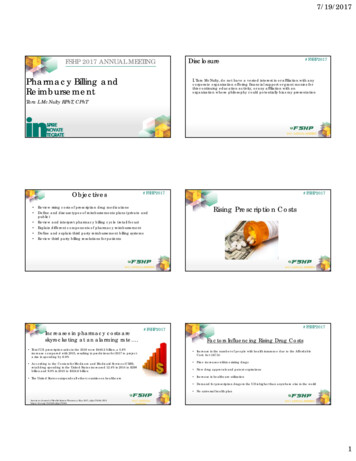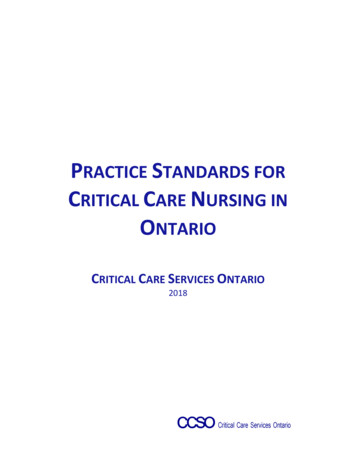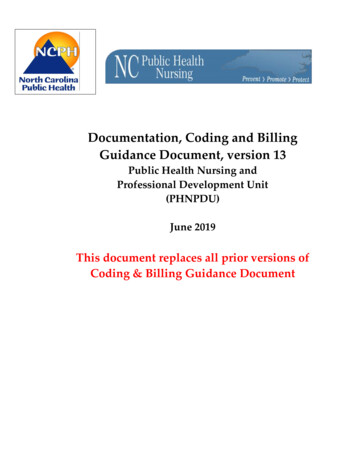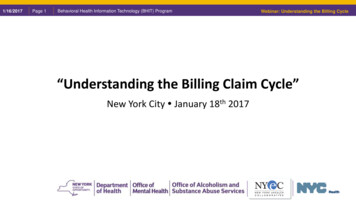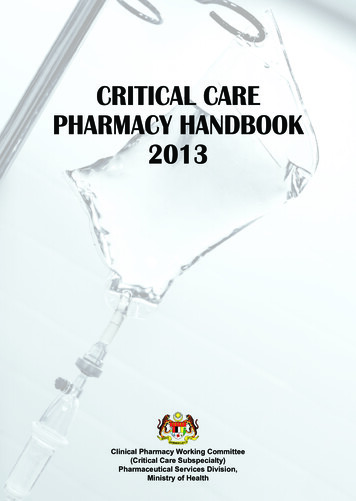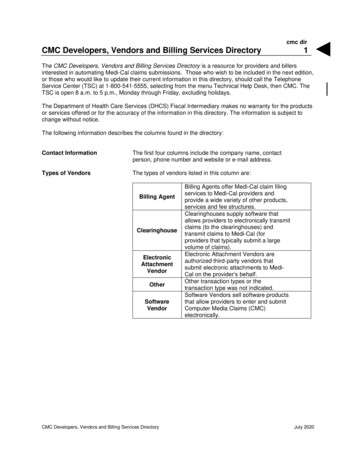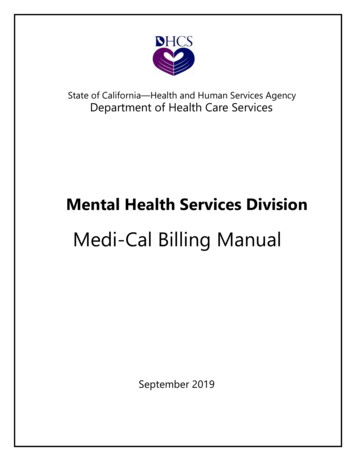
Transcription
Critical Care Documentation and BillingPresented By: Virginia Gleason, BSN, MPA, JD 2019 nThrive, Inc. All rights reserved. R031119
nThrive DisclaimerCopyright and Trademarks Statement. 2018 nThrive, Inc., a Delaware Corporation, with a business address at 200 North Point Center East, Suite600, Alpharetta, GA 30022 and its affiliates and subsidiaries (collectively, “nThrive”). All Rights Reserved. The nThrive name, associated trademarks,product names, and logos are owned by nThrive or related entities and may be registered with the United States Patent and Trademark Office.Confidentiality and Use Statement. Any information and related materials provided are owned by nThrive (collectively, the “Content”). No part of theContent may be reproduced, stored, disclosed, or transmitted in any form, or by any means, electronic, mechanical, photocopying, recording, scanning,or otherwise, without the express written permission of nThrive. The Content may contain proprietary information, comprising of trade secrets and knowhow owned or developed by nThrive. All users must maintain the confidentiality of all Content at all times.Information Statement. From time-to-time, the Content may refer to nThrive but may include references to customer statements, data, or statistics thatwere generated from the business operations of one of nThrive’s subsidiaries prior to the formation of nThrive. nThrive strives to provide accurateinformation in the Content, but assumes no responsibility or liability for any errors or inaccuracies that may appear. nThrive makes no warranty, expressor implied, regarding the accuracy, adequacy, completeness, legality, reliability, or usefulness of any Content provided and specifically disclaims anyimplied warranties of merchantability or fitness for a particular purpose. All Content is provided on an “as-is” basis.Company Statement. For more information, please visit www.nThrive.com.
Critical Care Documentation ED Services with Trauma ActivationAgenda Defining Critical Care ED Levels “Critical” Documentation Bundled Services and Separately Billable Services
ED Services withTrauma Activation
Trauma activation requirementsTo determine whether traumaactivation occurs, providers are tofollow the National Uniform BillingCommittee (NUBC) guidelines relatedto the reporting of the trauma revenuecodes in the 68x series.Can only be used by traumacenters / hospitals designatedby the state or asDifferent subcategory revenuecodes are reported bydesignated Level 1-5 hospitaltrauma centers (code 6899)Only patients for whom there hasbeen prehospital notification based ontriage information from prehospitalcaregiversMust meet field triage criteria,or delivered by inter-hospitaltransfers, and given theappropriate team responseWhen revenue code series 68x,trauma response, is billed inassociation with services other thancritical care, payment for traumaactivation is bundled into the otherservices provided on that day
Trauma activation factsWhat to chart Prearrival notice froma medical third party(time of providernotification and arrivalat facility) Reason / criteria foractivationThis documentation may be needed to dispute chargeswith payers and to track resource utilization.The trauma activation fee levels should not differ onthe basis of whether the patient was admitted or not. Thetrauma activation charge is for the level of response apatient received regardless of whether the patient isadmitted, is discharged, died, or is transferred.Likelihood of full reimbursement: Most likely: PRIVATE payers Less likely: "self-pay“, HMO’s, CMMS
Are Trauma Activation Fees included in your ED level of service?Trauma patients require hospitalsto expend higher level ofresources. Emergency department(ED) level of services does not coverthis additional cost burdenThe Uniform Billing (UB) revenue code68x, provides trauma designated hospitalsthe opportunity to bill for these costsThe ED level of services will bebilled according to a point system orusing the ACEP (American College ofEmergency Physicians) method ofassigning acuity, and the traumaactivation component will be billedunder the new revenue code 68x.
Trauma Activation Fees and ED level of service1For use by traumacenter / hospitals,licensed or designatedby the state or localgovernment authority,authorized as a traumacenter, or as verified bythe American Collegeof Surgeons and as afacility with a traumaactivation team.234Revenue Category 068Xis used for patients forwhom trauma activationoccurred. A trauma teamactivation / response is aNotification of key hospitalpersonnel in response totriage information frompre-hospital caregiversin advance of thepatient’s arrival.Revenue Category 068Xis for reporting traumaactivation costs only. It isan activation fee and not areplacement or a substitutefor the emergency room visitfee; if trauma activationoccurs, there will normallybe both a 045X and 068Xrevenue code reported.Revenue Category 068Xis not limited to admittedpatients.5Revenue Category 068Xmust be used inconjunction with FL 14Type of Admission / Visitcode 5 Trauma Center;however FL 14 Code 5 canbe used alone. Only patientsfor whom there has beenpre-hospital notification,who meet either local, stateor American College ofSurgeons field triagecriteria, or are delivered byinter-hospital transfers
Critical Care services with Trauma ActivationAt least 30 minutes of Critical CareWhen trauma activation occursallowing a charge under 68x andthe hospital provides at least 30minutes of critical care (CPTcode 99291), the hospital mayalso bill one unit of HCPCScode G0390.Less than 30 minutes of Critical CareHospitals that provide less than 30 minutes of critical care whentrauma activation occurs under revenue code 68x, may report acharge under 68x, but they may not report HCPCS code G0390.In this case, payment for the trauma response is packaged intopayment for the other services provided to the patient in theencounter, including the visit This means you can put a line item on your claim for trauma activation under revcode 68X, but there will not be a CPT / HCPCS code attached. PPS hospitals, even if a charge is attached to rev code 68X, they will not receive anAPC (Ambulatory Payment Classification) payment for this service.it is rolled upinto the EM service. You will (depending on payer / contract) receive payment forthat line item from your other commercial payers. For CAHs, they are not paid on an APC, so the line item charge under 68X willreceive payment on a reasonable cost
What is Critical Care?
Critical CareThe time that can be reported as critical care is the time spent by a physician and / or hospital staffengaged in active face-to-face critical care of a critically ill or critically injured patient. If the physicianand hospital staff or multiple hospital staff members are simultaneously engaged in this active face-toface care, the time involved can only be counted once. (ACEP)
Facility vs Provider Critical CareThere are differences in how facility and professional services are determined; codes assignedby the ED facility coder may not match those assigned by the ED physician coderED facility evaluation and management (E/M) levels are assigned using CPT ED services codes99281-99285 and, in some instances, critical care codes 99291-99292. There is no directcorrelation between the facility E/M level and the professional / physician level of service
Levels of ServiceThe physician or other qualified healthcare professionallevel of service is determined by the following:
1. Straight Forward Complexity (99281 / G0380):The presented problem(s) are self-limited orminor conditions with no medications orhome treatment required.Emergency department visit for the evaluationand management of a patient, which requiresthese 3 key components:1A problem focused history2A problem focused examination3Straightforward medical decision makingCounseling and / or coordination ofcare with other physicians, otherqualified health care professionals,or agencies are provided consistentwith the nature of the problem(s) andthe patient's and / or family's needs.Usually, the presenting problem(s)are self-limited or minor.
2. Low Complexity (99282 / G0381):The presented problem(s) are of low to moderateseverity. Over the counter (OTC) medications ortreatment, simple dressing changes; patientdemonstrates understanding quickly and easily.Emergency department visit for the evaluationand management of a patient, which requiresthese 3 key components:1An expanded problem focused history2An expanded problem focused examination3Medical decision making of low complexityCounseling and / or coordination ofcare with other physicians, otherqualified health care professionals,or agencies are provided consistentwith the nature of the problem(s) andthe patient's and / or family's needs.Usually, the presenting problem(s)are of low to moderate severity.
3. Moderate Complexity (99283 / G0382):The presented problem(s) are of moderate severity.Emergency department visit for the evaluationand management of a patient, which requiresthese 3 key components:1An expanded problem focused history2An expanded problem focused examination3Medical decision making of moderate complexityCounseling and / or coordination ofcare with other physicians, otherqualified health care professionals,or agencies are provided consistentwith the nature of the problem(s) andthe patient's and / or family's needs.Usually, the presenting problem(s)are of moderate severity.
4. Moderate-High Complexity (99284 / G0383):Usually, the presented problem(s) are of high severity,and require urgent evaluation by the physician but donot pose an immediate significant threat to life orphysiologic function.Emergency department visit for the evaluationand management of a patient, which requiresthese 3 key components:1A detailed history2A detailed examination3Medical decision making of moderate complexityCounseling and / or coordination ofcare with other physicians, otherqualified health care professionals,or agencies are provided consistentwith the nature of the problem(s) andthe patient's and / or family's needs.
5. High Complexity (99285 / G0384):The presented problem(s) are of high severityand pose an immediate significant threat to lifeor physiologic function.Emergency department visit for the evaluationand management of a patient, which requiresthese 3 key components:1A comprehensive history2A comprehensive examination3Medical decision making of high complexityCounseling and / or coordination ofcare with other physicians, otherqualified health care professionals,or agencies are provided consistentwith the nature of the problem(s) andthe patient's and / or family's needs.Usually, the presenting problem(s)are of high severity and pose animmediate significant threat to lifeor physiologic function.
Advanced Life Support (99288)Physician direction of Emergency Medical Systems (EMS)emergency care, advanced life support.
Critical Care (99291)The assignment of the Critical Care code 99291 likewise follows thesame instructions applicable to the six E&M codes listed above.There is a 30-minute time requirement for facility billing of critical care.The administration and monitoring of IV vasoactive medications (such asadenosine, dopamine, labetalol, metoprolol, nitroglycerin, norepinephrine,sodium nitroprusside, etc.) are indicative of critical care.
Instructions for ED Facility CPT Coding /Healthcare Common Procedure Coding System (HCPCS)The appropriate facility code /APC level is determined by theinterventions (of nursing andancillary ED staff) as listed in themiddle column marked "PossibleInterventions".Whether only a single"Possible Intervention" listedat a given facility code level ispresent or if multiple or all"Possible Interventions" assignedto that facility code level arepresent-the facility code / APClevel is still the same.The facility code levelassigned is always the highestlevel at which a minimum of one"Possible Intervention" is found.
Facility Charge Assignment TableLevelPossible InterventionsLevel 1: CPT 99281 Initial AssessmentType A: APC 609 No medication or treatments Rx refill only, asymptomaticType B: APC 626 Note for Work or SchoolHCPCS: G0380 Wound recheck Booster or follow up immunization, no acute injury Dressing changes (uncomplicated) Suture removal (uncomplicated) Discussion of Discharge Instructions (Straightforward)Potential Symptoms /Examples which support the Interventions Insect bite (uncomplicated) Read Tb test
Facility Charge Assignment TableLevelPossible InterventionsLevel II: CPT 99282Could include interventions from previous levels,plus any of:Type A: APC 613Type B: APC 627HCPCS: G0381 Tests by ED Staff (Urine dip, stool hem occult,Potential Symptoms /Examples which support the Interventions Localized skin rash Lesion Accucheck or Dextrostix) sunburn Visual Acuity (Snellen) Minor viral infection Obtain clean catch urine Eye discharge- painless Apply ace wrap or sling Ear Pain Prep or assist w / procedures such as: minorlaceration repair, I&D of simple abscess, etc. Urinary frequency without fever Discussion of Discharge Instructions (Simple) Simple trauma (with no X-rays)
Facility Charge Assignment TableLevelPossible InterventionsLevel III: CPT 99283Could include interventions from previous levels,plus any of:Type A: APC 614Type B: APC 628HCPCS: G0382 Receipt of EMS / Ambulance patientHeparin / saline lockNebulizer treatmentPreparation for lab tests described in CPT (80048-87999codes) Preparation for Electrocardiogram (EKG)Preparation for plain X-rays of only 1 area(hand, shoulder, pelvis, etc.)Prescription medications administered POFoley catheters; In and Out cathsC-Spine precautionsFluorescein stainEmesis / Incontinence carePrep or assist w / procedures such as: joint aspirationinjection, simple fracture care etc.Mental Health-anxious, simple treatmentRoutine psych medical clearanceLimited social worker interventionPost-mortem careDirect Admit via EDDiscussion of Discharge Instructions (ModerateComplexity)Potential Symptoms /Examples which support the Interventions Minor trauma(with potential complicating factors) Medical conditions requiring prescription drugmanagement Fever which responds to antipyretics Headache - History of, no serial exam Head injury - without neurologic symptoms Eye pain Mild dyspnea -not requiring oxygen
Facility Charge Assignment TableLevelPossible InterventionsLevel IV: CPT 99284Could include interventions from previous levels,plus any of:Type A: APC 615Type B: APC 629HCPCS: G0383 Preparation for 2 diagnostic tests: (Labs, EKG, X-ray)Prep for plain X-ray (multiple body areas):C-spine and foot, shoulder and pelvisPrep for special imaging study (CT, MRI, Ultrasound, VQscans)Cardiac Monitoring(2) Nebulizer treatmentsPort-a-cath venous accessAdministration and Monitoring of infusions or parenteralmedications (IV, IM, IO, SC) NG / PEGTube Placement / ReplacementMultiple reassessmentsPrep or assist w / procedures such as: eye irrigation withMorgan lens, bladder irrigation with 3-way foley, pelvicexam, etc.Sexual Assault Exam w / out specimen collectionPsychotic patient; not suicidalDiscussion of Discharge Instructions (Complex)Potential Symptoms /Examples which support the Interventions Blunt / penetrating trauma- with limiteddiagnostic testing Headache with nausea /vomiting Dehydration requiring treatment Vomiting requiring treatment Dyspnea requiring oxygen Respiratory illness relieved with (2) nebulizertreatments Chest Pain--with limited diagnostic testing Abdominal Pain - with limited diagnostic testing Non-menstrual vaginal bleeding Neurologic symptoms - with limited diagnostictesting
Facility Charge Assignment TableLevelPossible InterventionsLevel V: CPT 99285Could include interventions from previous levels,plus any of:Type A: APC 616Type B: APC 630HCPCS: G0384 Requires frequent monitoring of multiple vital signs (i.e. 02sat, BP, cardiac rhythm, respiratory rate) Preparation for 3 diagnostic tests: (Labs, EKG, X-ray) Prep for special imaging study (CT, MRI, Ultrasound, VQscan) combined with multiple tests or parenteral medicationor oral or IV contrast Administration of Blood Transfusion / Blood Products Oxygen via face mask or NRB Multiple Nebulizer Treatments: (3) or more (if nebulizer iscontinuous, each 20 minute period is considered treatment) Moderate Sedation Prep or assist with procedures such as: central lineinsertion, gastric lavage, LP, paracentesis, etc. Cooling or heating blanket Extended Social Worker intervention Sexual Assault Exam w / specimen collection by ED staff Coordination of hospital admission / transfer or change inliving situation or site Physical / Chemical Restraints; Suicide Watch Critical Care less than 30 minutesPotential Symptoms /Examples which support the Interventions Blunt / penetrating trauma requiring multiplediagnostic tests Systemic multi-system medical emergencyrequiring multiple diagnostics Severe infections requiring IV / IM antibiotics Uncontrolled DM Severe burns Hypothermia New-onset altered mental status Headache (severe): CT and / or LP Chest Pain--multiple diagnostic tests / treatmentsRespiratory illness-- relieved by (3) or more nebulizertreatments Abdominal Pain-- multiple diagnostic tests /treatments Major musculoskeletal injury Acute peripheral vascular compromise of extremities Neurologic symptoms - multiple diagnostic tests /treatments Toxic ingestions Mental health problem - suicidal / homicidal
Keys to Critical CareDocumentation and Billing
Critical Care (CPT 99291 Type A: APC 617)Critical Care can be coded based upon either the provision of any of the listed possible interventions or by satisfying the CriticalCare definition. A minimum of 30 minutes of care must be provided. Critical Care involves decision-making of high complexity toassess, manipulate, and support impairments of “one or more vital organ systems such that there is a high probability of imminentor life-threatening deterioration in the patient’s condition.” This includes, but is not limited to, “the treatment or prevention of furtherdeterioration of central nervous system failure, shock-like conditions, renal, hepatic, metabolic or respiratory failure, post-operativecomplications or overwhelming infection.” Under Outpatient Prospective Payment System (OPPS), the time that can be reported asCritical Care is the time spent by a physician and / or hospital staff engaged in active face-to-face critical care of a critically ill orcritically injured patient. If the physician and hospital staff or multiple hospital staff members are simultaneously engaged in thisactive face-to-face care, the time involved can only be counted once.
Critical Care Possible interventions:Could include interventions from previous levels, plus any or all of: Multiple parenteral medications requiring constantmonitoring Provision of any of the following: Major Trauma care / multiple surgical consultants Chest tube insertion Major burn care Treatment of active chest pain in acute coronarysyndrome (ACS) Administration of IV vasoactive meds(see guidelines) Cardiopulmonary Resuscitation (CPR) Defibrillation / Cardioversion PericardiocentesisAdministration of ACLS Drugs in cardiac arrestTherapeutic hypothermiaBi-PAP / CPAPEndotracheal intubationCricothyrotomyVentilator managementArterial line placementControl of major hemorrhagePacemaker insertion through a Central LineDelivery of baby
Critical Care Potential Symptoms /Examples which support the Interventions Multiple TraumaHead Injury with loss of consciousnessBurns threatening to life or limbComa of all etiologies (except hypoglycemic)Shock of all types: septic, cardiogenic, spinal,hypovolemic, anaphylacticDrug Overdose impairing vital functionsLife-threatening hyper / hypothermiaThyroid Storm or Addisonian CrisisCerebral hemorrhage of any typeNew-onset paralysisNon-hemorrhagic strokes with vital functionimpairment Status epilepticusAcute Myocardial Infarction Cardiac Arrhythmia requiring emergency treatmentAortic DissectionCardiac TamponadeAneurysm; thoracic or abdominal -- leaking or rupturedTension PneumothoraxAcute respiratory failure, pulmonary edema, statusasthmaticusPulmonary EmbolusEmbolus of fat or amniotic fluidAcute renal failureAcute hepatic failure Diabetic Ketoacidosis Lactic AcidosisDIC or other bleeding diatheses - hemophilia, ITP, TTP,leukemia, aplastic anemiaMajor Envenomation by poisonous reptiles
Additional Indicationsof Critical Care
Critical Care Vital Signs and Lab ValuesAbnormal VITAL SIGNS to consider for CCT: O2 Sat (pulse ox) or 90 Temperature (adult) 95 Respirations (adult / child) or 30 Heart rate / pulse (adult) 120 Respirations (adult / child) 5 Heart rate / pulse (adult) 40 Respirations (adult / child),intercostal retractions, nasal flaring,Cheyne-Stokes or tachypnea Systolic BP (adult) 200 or 90 Temperature (adult) 104 F Diastolic BP (adult) 110 or 40 Glasgow Coma Score (GCS) 13
Critical Care Vital Signs and Lab Values (cont.)Electrolyte Imbalance Sodium (Na) 120 or 150Other Labs ABGs Potassium (K) 2 or 5.5–pCO2 30 or 50 mm Hg Calcium (Ca) 6 or 13 mg / dl–pO2 60 mm Hg Magnesium 1.5 or 5 meq / L–O2 Sat (pulse ox) or 90% Bicarbonate (C02) 10 or 40 mEq / L–pH 7.3 or 7.5 Platelet count 20,000 Hemoglobin (Hbg) or 9 Troponin above normal CK MB than or 5% WBC 2K or 20K / μl
Back to HCPCS: Critical Care (CPT 99292)As above in additional 30-minute increments. Record the TOTAL criticalcare time. The first 30-74 minutes’ equal code 99291. If used, additional 30minute increments (beyond the first 74 minutes) are coded 99292. Medicaredoes not pay for code 99292 because it is considered packaged into 99291;however, the services should be reported as appropriate.
Critical care with Trauma Team Activation (APC 618 / G0390)In addition to 99291, designated trauma centers may report theTrauma Team Activation code G0390 when a trauma team wasactivated and all other trauma activation criteria are met.
Critical Care Documentation
What’s needed for nurse documentation? Time of notification from EMS What was reported by EMS Full names of providers contacted and time of contact Activation of trauma team Documentation of Critical Results Date, time and name of person receiving the critical result Date, time and name of provider given the results Measures taken to correct the critical results, if any Patient’s response to treatment
Telehealth / Tele-ER documentation Key Documentation Elements: Where telehealth unit was used Time telehealth was connected and by whom Name and specialty of physician Time physician evaluation started If orders were received from telehealth physician Time telehealth visit disconnected / concluded Any follow-up recommendations from telehealth physician Date / Time of appointments and name of physician
Bundled Services andSeparately Billable
Critical care bundled servicesDescriptionInterpretation of cardiac output measurementsPulse oximetryChest x-rays, Professional componentBlood gases, and information data stored in computers - e.g.,ECGs, blood pressures, hematologic dataGastric intubationTranscutaneous pacingVentilator managementPeripheral vascular access procedures
Services documented separately (not a complete list)Endotracheal IntubationCPRSplinting*Electrical cardioversion*Central vascular / venous accessBronchoscopy*IO placementLaceration Repair*Transvenous pacing*Radiology Interpretations and ReportChest tube placement*IV infusions / injectionsBladder catheterization*Remember to Document Moderate Sedation Time
Subtracting time for separately reportable / non-bundled proceduresExample of standardtimes used forcalculationsCPT Code3150031603316053200 324213242232551DescriptorEndotracheal IntugationTranstracheal TracheostomyCricothyroidPuncture thoracentesisThoracentesis w / tube insertionThoracostomy / Chest Tube insertionProfessional Time (MIN.)111155Facility Time -51703PericardiocentesisTempory transvenous pacingPlacement of non-tunneled centrallyinserted central venous catheterIntraosseous infusionBladder catheterization2N/A92950CPRTotal time compressions are beingperformed or total time between CPRstart and CPR stop time22 (if not bundled withanother procedure)Same as professional9301070000 seruesm Echocardiograms and duplexscans96360-9636812 Lead ECGRadiology interpretations and Report(includes xrays andultrasounds)111N/AIV InfusionsN/A96372-96376InjectionsN/A5 (each separateinfusion)1
Questions
References and ResourcesAmerican College of Emergency Physicians (ACEP);ED Facility Level Coding GuidelinesAmerican Academy of Professional Coders (AAPC); Casssano, Holly J.;Ten Commandments of Critical Care in the ERAmerican Academy of Professional Coders (AAPC); Verhovshek, John;Visit the Facility Side of ED Coding
Oct 03, 2019 · The assignment of the Critical Care code 99291 likewise follows the same instructions applicable to the six E&M codes listed above. There is a 30-minute time requirement for facility billing of critical care. Critical Care (99291) The administra

